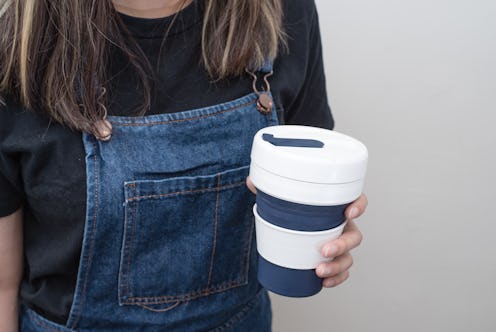
You carry it everywhere, drink from it on the daily, and fill it with beverage after beverage. And yet, despite its constant presence in your life, it can be difficult to remember to clean your reusable coffee cup. Sure, there's residue left inside from half and half, and a brown ring from various espresso drinks. But since it's so much easier to rinse, refill, and repeat, these things are often left to fester.
Of course, while slightly gross, it isn't the end of the world if you accidentally go a few days between washes, or cast a blind eye to the formation of stains. But experts do recommend you try to wash your mug after every use — with soap and hot water — to prevent the build up of germs that have a tendency to gather inside.
"The warm condensation that emits from hot coffee creates a great place for germs and bacteria to multiply," Dr. Nidhi Ghildayal, an infectious disease specialist and PhD from the University of Minnesota School of Public Health, tells Bustle. And if you add milk, whether in hot coffees or iced drinks, it can easily stay behind in residue form, she says, which can then spoil, and possibly even lead to an upset stomach.
Your reusable coffee mug is also going to be set down in numerous germ-y locations, from the train, to a crowded meeting, to shared counters at work, "which means it is coming into contact with numerous germs from multiple people," Rebecca Park, a registered nurse and founder of RemediesForMe.com, tells Bustle.
To spare yourself having to drink from a germ-y cup, or possibly increasing your risk of catching a cold, it can help to buy a reusable mug that's easy to wash, mostly "because you'll be more likely to clean it," Ghildayal says. "Sliding-top coffee cups are a great place for bacteria to fester and often don't get cleaned properly for this reason."
Some folks have even reported finding mold in the crevices of their travel mug lids, since this area can be difficult to wash thoroughly. According to the USDA, these molds can make you sick, which is why it's a good idea to take your mug apart, clean the lid and all other crevices thoroughly, and then try to make that a part of your daily routine. And once you're in the market for a new cup, go for one that has a simpler design, as well as one that can be put in the dishwasher, if that's an option.
"Generally, a dishwasher is best if your item is dishwasher-safe; but using soap, hot water, and deeply wiping the corners and crevices of your cup with a paper towel works as well," Ghildayal says. Again, this is something you should do after every use, she says, and not with an old communal kitchen sponge, as that will only introduce more bacteria.
Instead, grab a towel or a scrub brush and toss your cup into the sink. "Mechanical washing will remove 95% of all the germs and the hot, soapy water will do the rest," Dr. Michael Hall, a board-certified doctor with the American Board of Family Medicine, tells Bustle. "You can always add a dash of [bleach] to the hot soapy water to make the germ killing more effective.”
From there, "dry your coffee cup with a paper towel," Park says, so that mold and bacteria won't form as it dries, and you should be good to go. Carrying around a reusable coffee mug is a great idea, so you aren't contributing to the massive amount of plastic thrown away every day. And it's something you can do safely and cleanly, by simply washing your mug more often.
Experts:
Dr. Nidhi Ghildayal, infectious disease specialist and PhD from the University of Minnesota School of Public Health
Rebecca Park, registered nurse and founder of RemediesForMe.com
Dr. Michael Hall, board-certified doctor with the American Board of Family Medicine